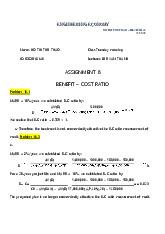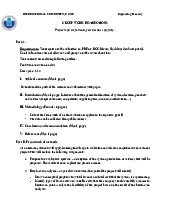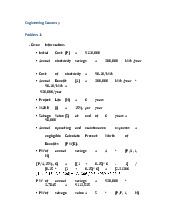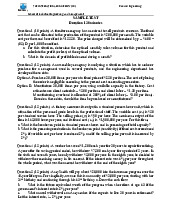

















Preview text:
lOMoAR cPSD| 58583460 Engineering Economics 4-1 Cash Flow
Cash flow is the sum of money recorded
as receipts or disbursements in a
project ’ s financial records.
A cash flow diagram presents the flow of
cash as arrows on a time line scaled to
the magnitude of the cash flow, where
expenses are down arrows and receipts are up arrows.
Year-end convention ~ expenses occurring during the year are
assumed to occur at the end of the year. Example (FEIM):
A mechanical device will cost $20,000
when purchased. Maintenance will cost
$1000 per year. The device will generate
revenues of $5000 per year for 5 years. The salvage value is $7000. lOMoAR cPSD| 58583460 Engineering Economics 4-2a1
Discount Factors and Equivalence
Present Worth (P): present amount at t = 0
Future Worth (F): equivalent future amount at t = n of any present amount at t = 0
Annual Amount (A): uniform amount that repeats at the end of each year for n years
Uniform Gradient Amount (G): uniform gradient amount that repeats at
the end of each year, starting at the end of the second year and
stopping at the end of year n.
Professional Publications, Inc. lOMoAR cPSD| 58583460 Engineering Economics 4-2a2
Discount Factors and Equivalence NOTE: To save time, use the calculated factor table provided in the NCEES FE Handbook. lOMoAR cPSD| 58583460 Engineering Economics 4-2b
Discount Factors and Equivalence Example (FEIM):
How much should be put in an investment with a 10% effective annual
rate today to have $10,000 in five years?
Using the formula in the factor conversion table,
P = F(1 + i) –n = ($10,000)(1 + 0.1) –5 = $6209
Or using the factor table for 10%,
P = F(P/F, i%, n) = ($10,000)(0.6209) = $6209
Professional Publications, Inc. FERC lOMoAR cPSD| 58583460 Engineering Economics 4-2c
Discount Factors and Equivalence Example (FEIM):
What factor will convert a gradient cash flow ending at t = 8 to a future value? The
effective interest rate is 10%.
The F/G conversion is not given in the factor table. However, there are different ways
to get the factor using the factors that are in the table. For example,
(F/G,i%,8) = (P/G,10%,8)(F/P,10%,8) = (16.0287)(2.1436) = 34.3591 or
(F/G,i%,8) = (F/A,10%,8)(A/G,10%,8) = (11.4359)(3.0045) = 34.3592
NOTE: The answers arrived at using the formula versus the factor table turn out
to be slightly different. On economics problems, one should not worry about getting the exact answer. FERC lOMoAR cPSD| 58583460 Engineering Economics 4-3 Nonannual Compounding
Effective Annual Interest Rate
An interest rate that is compounded more than once in a year is converted from
a compound nominal rate to an annual effective rate.
Effective Interest Rate Per Period
Effective Annual Interest Rate Example (FEIM):
A savings and loan offers a 5.25% rate per annum compound daily over 365 days
per year. What is the effective annual rate? " r %m " 0.0525%365 i = $ e 1 + m’& (1= $#1 + 365 ’& (1= 0.0539 # lOMoAR cPSD| 58583460 Engineering Economics 4-4
Discount Factors for Continuous Compounding
The formulas for continuous compounding are the same formulas in the
factor conversion table with the limit taken as the number of periods, n, goes to infinity.
Professional Publications, Inc. FERC lOMoAR cPSD| 58583460
Professional Publications, Inc. lOMoAR cPSD| 58583460 Engineering Economics 4-5a Comparison of Alternatives Present Worth
When alternatives do the same job and have the same lifetimes,
compare them by converting each to its cash value today. The superior
alternative will have the highest present worth. Example (EIT8): lOMoAR cPSD| 58583460 FERC lOMoAR cPSD| 58583460 Engineering Economics 4-5b1 Comparison of Alternatives Capitalized Costs
Used for a project with infinite life that has repeating expenses every year.
Compare alternatives by calculating the capitalized costs (i.e., the
amount of money needed to pay the start-up cost and to yield enough
interest to pay the annual cost without touching the principal).
NOTE: The factor conversion for a project with no end is the limit of the
P/A factor as the number of periods, n, goes to infinity. lOMoAR cPSD| 58583460 Engineering Economics 4-5b2 Comparison of Alternatives Example (EIT8): lOMoAR cPSD| 58583460 Engineering Economics 4-5c Comparison of Alternatives Annual Cost
When alternatives do the same job but have different lives, compare the
cost per year of each alternative.
The alternatives are assumed to be replaced at the end of their lives by
identical alternatives. The initial costs are assumed to be borrowed at
the start and repaid evenly during the life of the alternative. Example (EIT8): lOMoAR cPSD| 58583460 Engineering Economics 4-5d Comparison of Alternatives Cost-Benefit Analysis
Project is considered acceptable if B – C ≥ 0 or B/C ≥ 1. Example (FEIM):
The initial cost of a proposed project is $40M, the capitalized perpetual
annual cost is $12M, the capitalized benefit is $49M, and the residual
value is $0. Should the project be undertaken?
B = $49M, C = $40M + $12M + $0
B – C = $49M – $52M = –$3M < 0
The project should not be undertaken. lOMoAR cPSD| 58583460 Engineering Economics 4-5e Comparison of Alternatives
Rate of Return on an Investment (ROI)
The ROI must exceed the minimum attractive rate of return (MARR).
The rate of return is calculated by finding an interest rate that makes the
present worth zero. Often this must be done by trial and error. lOMoAR cPSD| 58583460 Engineering Economics 4-6a Depreciation Straight Line Depreciation
The depreciation per year is the cost minus the salvage value divided by the years of life. lOMoAR cPSD| 58583460 Engineering Economics 4-6b Depreciation
Accelerated Cost Recovery System (ACRS)
The depreciation per year is the cost times the ACRS factor (see the
table in the NCEES Handbook). Salvage value is not considered.
Professional Publications, Inc. FERC lOMoAR cPSD| 58583460 Engineering Economics 4-6c Depreciation Example (FEIM):
An asset is purchased that costs $9000. It has a 10-year life and a salvage
value of $200. Find the straight-line depreciation and ACRS depreciation for 3 years.
Straight-line depreciation/year = = $880/yr ACRS depreciation First year ($9000)(0.1) = $ 900 Second year ($9000)(0.18) = $1620 Third year ($9000)(0.144) = $1296 lOMoAR cPSD| 58583460 Engineering Economics 4-6d Depreciation Book Value
The assumed value of the asset after j years. The book value (BVj) is the
initial cost minus the sum of the depreciations out to the jth year. Example (FEIM):
What is the book value of the asset in the previous example after 3 years
using straight-line depreciation? Using ACRS depreciation? Straight-line depreciation $9000 – (3)($800) = $6360 ACRS depreciation
$9000 – $900 – $1620 – $1296 = $5184 lOMoAR cPSD| 58583460 Engineering Economics 4-7a Tax Considerations
Expenses and depreciation are deductible, revenues are taxed. Example (EIT8):





